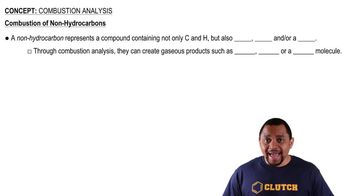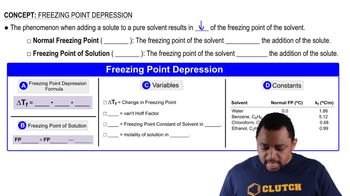The steroid hormone estradiol contains only C, H, and O; combustion analysis of a 3.47 mg sample yields 10.10 mg CO2 and 2.76 mg H2O. When dissolving 7.55 mg of estradiol in 0.500 g of camphor, the melting point of camphor is depressed by 2.10 °C. What is the molecular weight of estradiol, and what is a probable formula? [For camphor, Kf = 37.7 °C kg/mol.]
 Verified step by step guidance
Verified step by step guidanceKey Concepts
Combustion Analysis

Freezing Point Depression

Molecular Weight and Empirical Formula

Treatment of 1.385 g of an unknown metal M with an excess of aqueous HCl evolved a gas that was found to have a volume of 382.6 mL at 20.0 °C and 755 mm Hg pressure. Heating the reaction mixture to evaporate the water and remaining HCl then gave a white crystalline compound, MClx. After dissolving the compound in 25.0 g of water, the melting point of the resulting solution was - 3.53 °C. (b) What mass of MClx is formed? (a) How many moles of H2 gas are evolved?
Treatment of 1.385 g of an unknown metal M with an excess of aqueous HCl evolved a gas that was found to have a volume of 382.6 mL at 20.0 °C and 755 mm Hg pressure. Heating the reaction mixture to evaporate the water and remaining HCl then gave a white crystalline compound, MClx. After dis- solving the compound in 25.0 g of water, the melting point of the resulting solution was - 3.53 °C. (c) What is the molality of particles (ions) in the solution of MClx?
